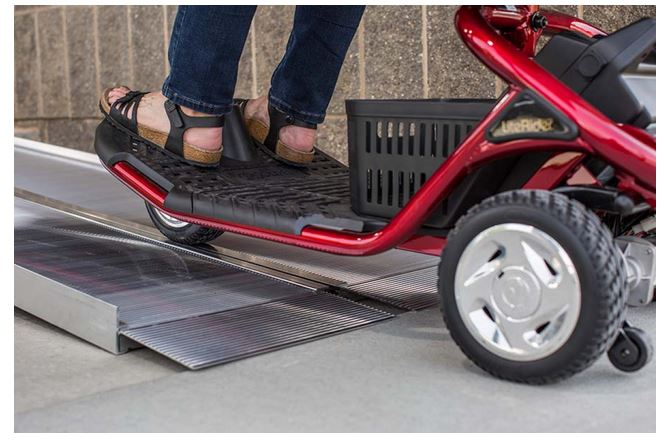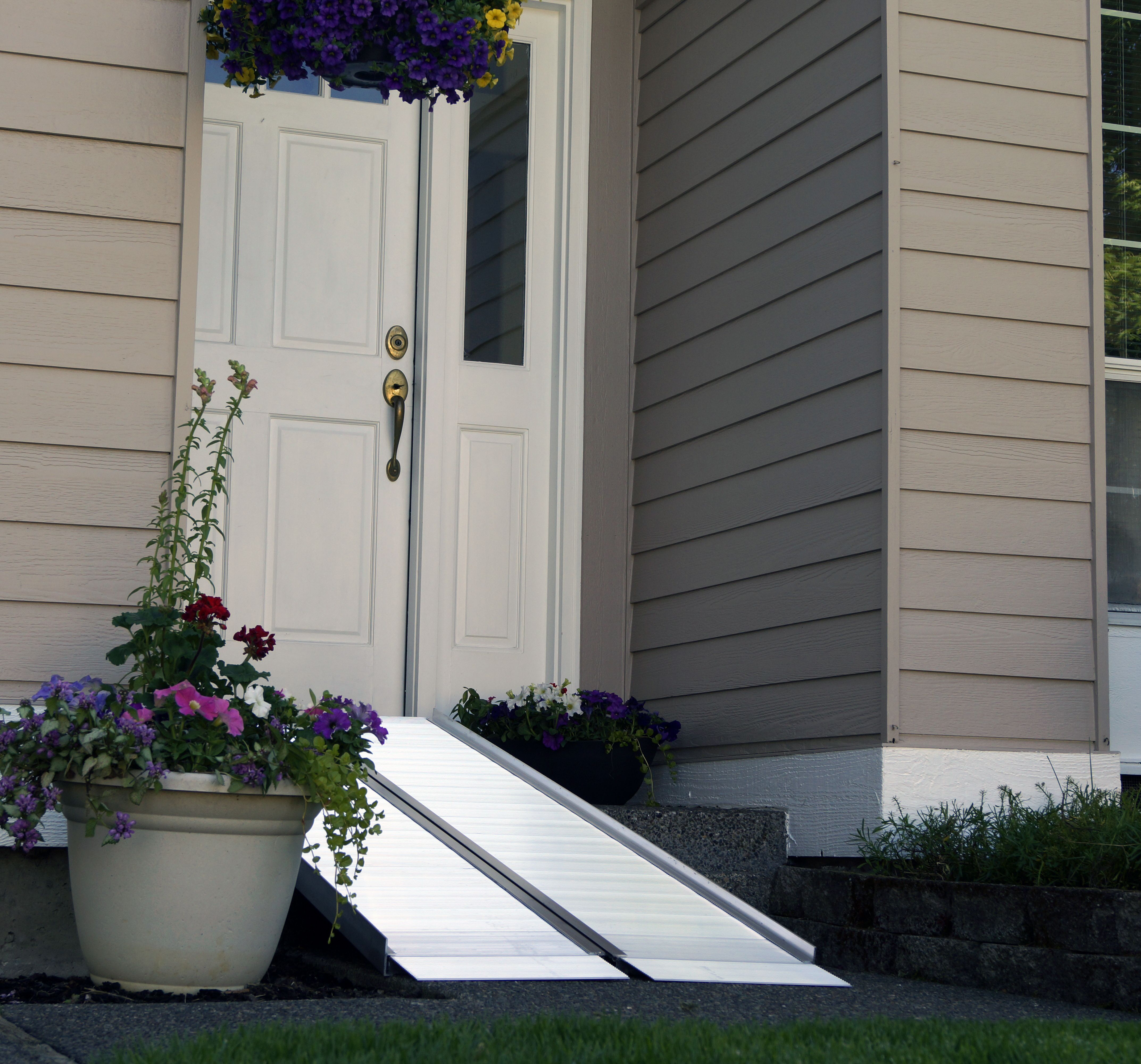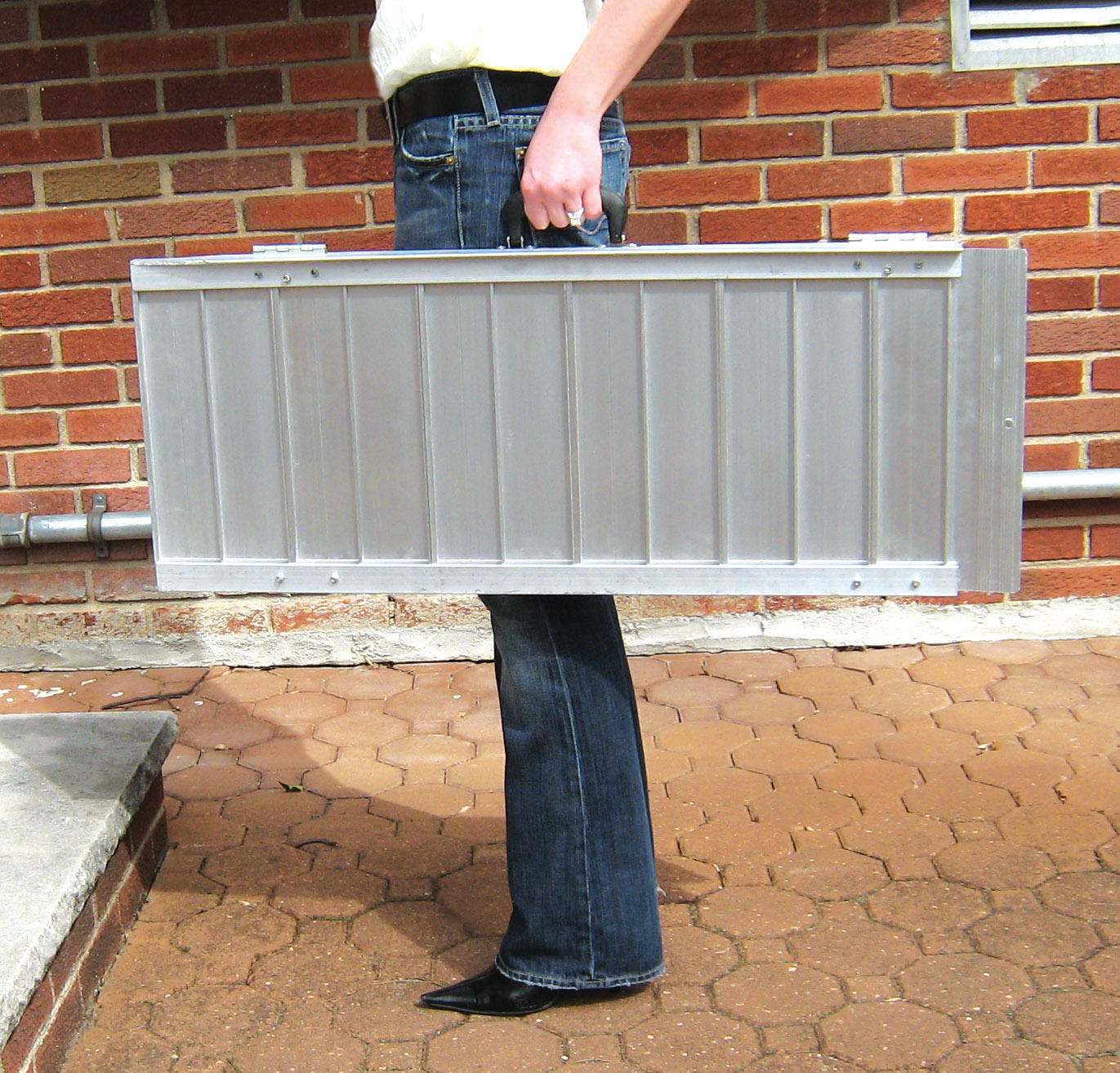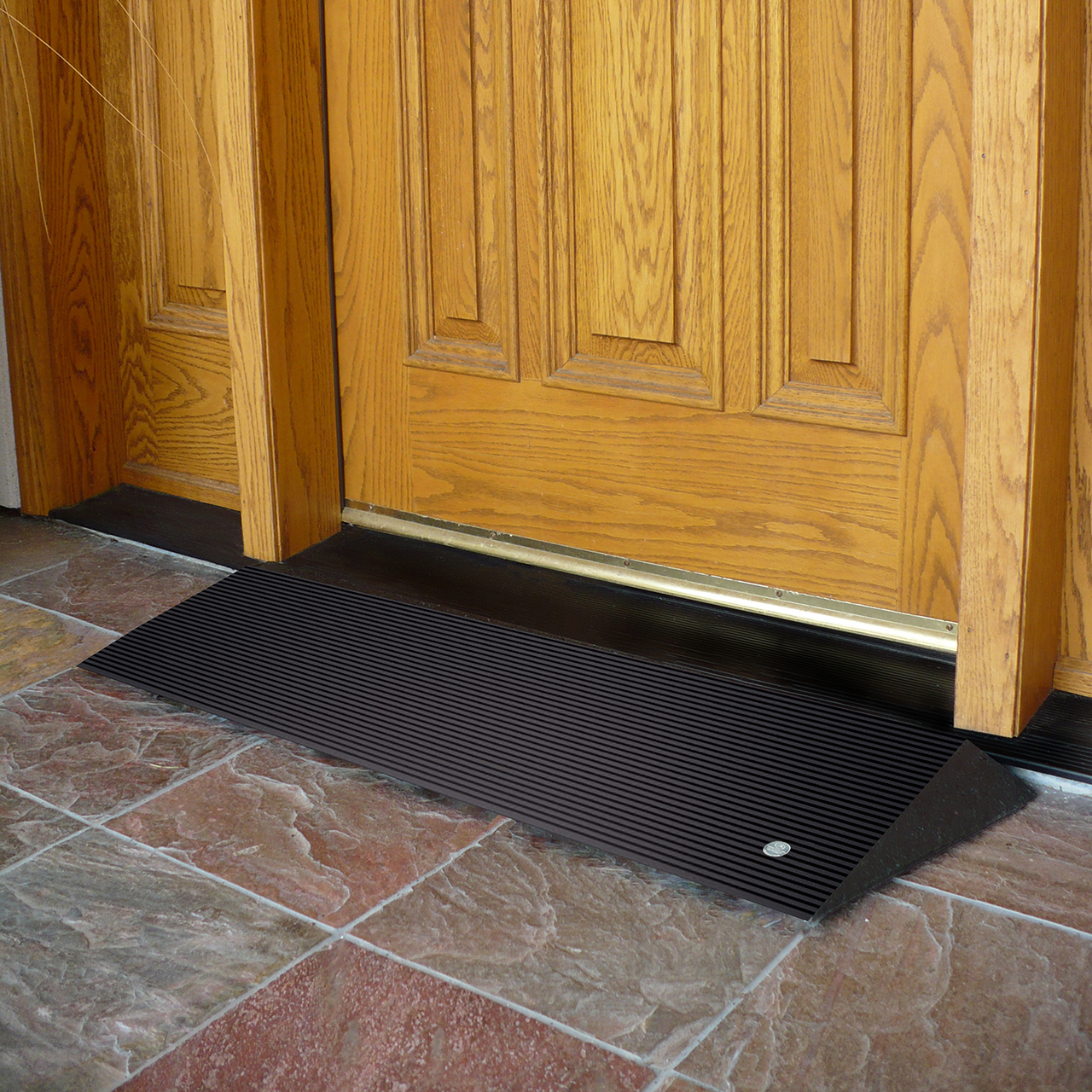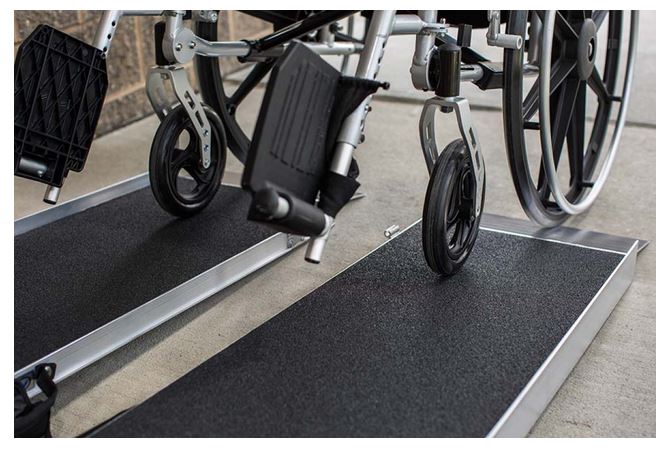8 Myths About Buying Wheelchair Ramps
4th May 2015
Typically when one thinks about a wheelchair ramp, a long modular ramp winding several feet down at a gradual slope comes to mind. Other thoughts may include, “That stair ramp looks too expensive”, “I can’t imagine all of the work that went into constructing and installing that step ramp”, “For all of that money, how long is it really going to last?” and “I would hate to have a permanent ramp like that in the front of my house. What an eye sore.” I have good news for you: wheelchair ramps do not have to be expensive, permanent or difficult to install. In fact many residential wheelchair ramps are affordable, temporary, portable, safe and strong. Let’s debunk these myths so you can see just how beneficial purchasing a wheelchair ramp can be.
Myth #1: High Cost
“Wow that ramp must have been very costly to build.”
One of their first assumptions people may have about a wheelchair ramp is that they are too expensive to construct and maintain. Sure a scooter ramp may be a financial investment, but it also is an investment in safety and health. One trip over a threshold or a fall down the stairs can cost someone thousands in medical bills. Would you rather pay thousands of dollars in medical bills or a hundred dollars or less for a stair ramp?
There are several ramps available in a variety of styles and price points to meet each person’s needs and budget. Many of the ramps on the market today are very affordable ranging in price from $50 up to $700 depending on the ramp. Threshold wheelchair ramps are relatively low in price due to their small size and lightweight materials used. Because of their extended length and heavy duty construction, trifold ramps are typically the most costly. Fortunately there are several options of threshold ramps, suitcase ramps, entry mats, etc. at various prices for you to choose from. The bottom line is this: you control how much you want to spend on the ramp!
Myth #2: Difficult Install
“I am going to have to hire someone to install this ramp. It just gets too complicated.”
Another assumption many people have about wheelchair ramps is that these slopes are complicated to install. All portable stair ramps, whether threshold, modular, suitcase or trifold, are created with the capabilities and strengths of the average person in mind. The manufacturers know that most people do not want to spend the extra money nor deal with the hassle of hiring outside help for the install. So they design wheelchair ramps with an easy install plan in mind and write simple instructions that the majority of people will be able to follow and complete in a few minutes time. Since these ramps are portable and could potentially be moved several times, a quick and easy setup is the only option that makes sense. Since you will be the install technician, make sure to follow the instructions for a secure install. If you need help, don’t be afraid to call customer service for tips and tricks on installation- that is what they are there for!
Myth #3: Permanent Renovation
“I don’t want to make a permanent renovation to my home.”
A third assumption people commonly have about wheelchair ramps is that they are a permanent renovation to the home. If you want to build a large winding wooden or metal modular ramp, then yes it will be a permanent structure. But remember that there are many other temporary options available to help you avoid this renovation. For example, say there is a 6 inch step leading up to your front door that you would like to place a ramp over. An aluminum folding ramp that is three feet in length will provide the proper length and incline for someone walking on their own or riding in a wheelchair. This ramp can be moved at any time yet is also secure to support a user and a mobility aid. If you are having people over that you do not want to see the ramp, simply remove it!
Myth #4: No Portability
“I need a ramp in so many places in and around my home, not to mention if I travel.”
Usually someone who needs one ramp at their home will need a ramp somewhere else within their home, whether it be the garage, front door, or a threshold. This leads to the thought, “The more ramps I need, the more I must pay.” But that does not have to be case. Because these doorway ramps are temporary, they are also created to be portable. Many ramp designs feature heavy duty yet comfortable handles to help with transferring the ramp from one location to another. Some portable ramps even come with a carry bag to not only aid in transport but to protect the ramp from any damage that may occur during the move.
Suitcase ramps are especially useful for traveling. If you are visiting a location outside the home, this ramp is very convenient to fold and store in your vehicle. If the ramp is too heavy to be carried, simply remove the hinge pins to separate the ramp into two compact, lightweight sections. Either way, portable ramps offer versatility anytime, anywhere.
Myth #5: Not Safe
“Yes these ramps are portable, but are they safe and secure to use?”
The purpose of purchasing a mobility ramp in the first place is to provide a smooth, gradual transition over a potential tripping hazard or mobility hurdle. Wheelchair ramp manufacturers have added many features to ensure that ramps are as safe as possible for their users. A skid resistant surface with an extruded track provides great traction to people and wheelchairs alike. Perforated slots on the ramp surface prevent water from collecting and reduce the risk of slips and falls. The hinge on suitcase and trifold ramps is an additional safety feature. Plus a self-adjusting bottom transition plate makes transfers more secure. With all of these features plus proper installation and a gentle slope, this ramp will more than ease your security concerns.
Myth #6: Short Life Span
“Even if I installed this ramp today, how long will it last?”
A reservation many people have about wheelchair ramps are their longevity. The weather will certainly takes its toll on a residential wheelchair ramp, not to mention the wear and tear from the constant traffic and use. Fortunately, manufacturers took these concerns into account with their ramp designs, creating products that are made for high traffic use in all weather conditions. No need to approach the ramp straight on- beveled edges on select styles of doorways allow cross-traffic, making it easy to access the ramp from all angles. Materials such as recycled rubber and air-craft grade aluminum are used to handle the rain, snow, mud and dirt that are bound to come in contact with the ramp. In fact, this type of aluminum is so high quality that it will withstand rust and corrosion. Despite the harshest weather conditions, there is no need to be worried about how long this ramp will last.
Myth #7: Low Strength & Durability
“Can this small ramp really support my weight plus the weight of my mobility equipment?”
From lightweight canes to heavy motorized scooters, these small ramps can support whichever mobility aid you choose to use. Typically most stair ramps can support between 600-800 lbs. of weight. Some ramps can support up to 850 lbs to accommodate the weight of the user plus their wheelchair, scooter, etc. Ramp materials such as recycled rubber and air craft grade aluminum allow the ramps to be strong and safe yet light and portable. Furthermore, suitcase and trifold ramps feature a full length hinge for more stability. No matter the threshold, doorway or stairway, these ramps will deliver the structural reinforcement to help you and your loved ones feel secure.
Myth #8: Unknown Length
"I don’t know how long of a ramp I need.”
Luckily the ADA offers easy to understand guidelines to assist you with calculating and identifying the length of the ramp you need. Let’s start with the basics. The higher the vertical rise, the longer the wheelchair ramp needed to provide the gentlest slope. A portable ramp should not be used to accommodate a vertical rise of over 30 inches.
Now the specifics. We will focus on ADA requirements for mobility ramps in residential areas. There are two types of use for wheelchair ramps: occupied and unoccupied. Occupied means that one person is sitting in the scooter or wheelchair as the caregiver pushes it up the ramp. Unoccupied means that no person is sitting in the scooter or wheelchair as the caregiver pushes it up the ramp.
1. Occupied Ramp Standards: The ADA recommends a slope of 3.12. This requires that for every 3” of vertical rise, there is at minimum 1’ of ramp length. For example, a 12” rise would need a ramp length of at least 4’. (12 divided by 3)
2. Unoccupied Ramp Standards: The ADA recommends a slope of 2.12. This requires that for every 2” of vertical rise, there is at minimum 1’ of ramp length. For example, a 12” rise would need a ramp length of at least 6’. (12 divided by 2)
Keep the safety of yourself and your loved one in mind by choosing a ramp with the least amount of slope. Don’t skimp on length because you want to save money- you may pay for it later!
From home entry to car access, there are many reasons a wheelchair ramp is used to assist with basic mobility and transport. We hope the eight reasons above comforted your fears about buying a wheelchair ramp and gave you the opportunity to see these ramps in a new, positive light. For more information, check out our wheelchair ramps category here: http://www.mycarehomemedical.com/ramps-scooter-wheelchair-accessibility/


